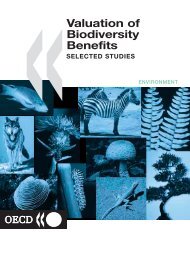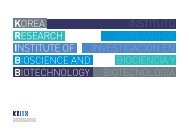Create successful ePaper yourself
Turn your PDF publications into a flip-book with our unique Google optimized e-Paper software.
Article 9<br />
Complete separation of triangular gold nanoplates<br />
through selective precipitation under CTAB micelles<br />
in aqueous solution<br />
Article 10<br />
Label-free and naked eye detection of PNA/DNA<br />
hybridization using enhancement of gold nanoparticles<br />
Chem Commun (Camb). 2010 May; 46(18):3164-6.<br />
Chem Commun (Camb). 2010 May; 46(19):3315-7.<br />
Ha TH * , Kim YJ, Park SH<br />
Kim SK, Cho H, Jeong J, Kwon JN, Jung Y, Chung BH *<br />
* Correspondence: taihwan@kribb.re.kr<br />
BioMonitoring Research Center<br />
* Correspondence: chungbh@kribb.re.kr<br />
BioNanotechnology Research Center<br />
Triangular gold nanoplates in CTAB solution were selectively<br />
precipitated on a glass wall in ambient conditions<br />
and the nanoplates could be easily recovered by a brief<br />
sonication.<br />
PMID: 20424761<br />
Keywords: Cetrimonium compounds; Chemical<br />
precipitation; Gold nanoparticle; Metal<br />
nanoparticles; CTAB micelles; Water<br />
We demonstrated a new method for the labelfree detection<br />
of DNA using the gold enhancement process after inducing<br />
the electrostatic interaction between the positively charged<br />
gold nanoparticles and the negatively charged target DNA<br />
hybridized to the neutral PNA capture probes. Among the<br />
various sizes of gold nanoparticles, 4 nm gold nanoparticles<br />
were found to exhibit the optimal response. In this method,<br />
the target-bound spot can be visualized by the naked eye<br />
or by using a commercialized optical grayscale flatscanner.<br />
The grayscale levels were proportional to the concentration<br />
of the target DNA within the range of 10 pM to 100 nM,<br />
exhibiting comparable sensitivity to the fluorescence method.<br />
It is expected that this novel method offers the potential<br />
for label-free DNA detection in a cost-effective manner.<br />
Utilizing a gold enhancement process after inducing electrostatic<br />
interaction between positively charged gold nanoparticles<br />
and negatively charged target DNA hybridized to<br />
neutral PNA capture probes, a new method for label-free<br />
detection of DNA was developed and successfully applied<br />
to detect H5-type DNA.<br />
PMID: 20361103<br />
Keywords: DNA; Gold; In situ hybridization; Metal<br />
nanoparticles; Particle size; Peptide nucleic acids;<br />
Static electricity; Surface properties<br />
2010 KRIBB Article Abstracts | 7 |












